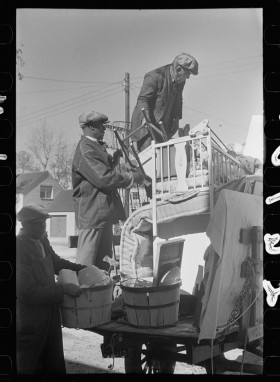 Gordon Parks. Dorothea Lange. Arthur Rothstein. Marion Post Wolcott. Between 1935 and 1944, these men and women, and dozens of other photographers, captured images of everyday America that are a treasure for historical researchers. Have you used their work?
Gordon Parks. Dorothea Lange. Arthur Rothstein. Marion Post Wolcott. Between 1935 and 1944, these men and women, and dozens of other photographers, captured images of everyday America that are a treasure for historical researchers. Have you used their work?
At first, the photographers focused on the rural South, documenting the lives of mostly nameless sharecroppers—black, white, and in-between. Before the project ended, they had pushed into all corners of America, capturing industrialization in the Northeast, agricultural workers in the Midwest, and migrants to the Western states. Some of the photographers were given specific assignments. Others were encouraged to capture whatever spoke to them or tugged on their hearts. Most received some training in how-to-interview subjects and draw out their stories.
Almost consistently, the people they imaged go unnamed. Photographs are typically captioned to “tell the story” captured by the photographer. The labels they applied to people can make us wince—as seen on the series that I’m presently running at my Facebook page, Forgotten People: Cane River’s Creoles of Color.
The collected works of these photographers are housed today in the Library of Congress. They offer us some 107,000 photographic prints and even more black and white negatives and color transparencies—more than 1,600 of the latter. All are copyright free, although (as with everything we use, everywhere) we’re expected to give credit when we use them in our own writings and postings.
The gateway to this fantastic collection is https://www.loc.gov/collections/fsa-owi-black-and-white-negatives/about-this-collection/. Here, you may query for a locale. Or an occupation. Or a type of type of building or event. You’ll find everything from “moving” day to county fairs, from “factory girls” in Manchester, New Hampshire, to furniture craftsmen in West Virginia, and workers at sugar-beet factories in Colorado.
When photographs are localized to a specific place you are researching, do share these in Facebook pages for that region. Few of the men, women, and children in these photographs are alive today; but some have still-living children who recogize their family members and can give us names. We need to preserve those identifications before the memories are gone.
PHOTO CREDITS: Arthur Rothstein, “Moving into a new home, Newport News Homesteads, Virginia,” December 1937, LC control no. 2017723023, Farm Security Administration/Office of War Information Black-And-White Negatives, Prints & Photographs Division, Library of Congress, Washington, DC; imaged in Library of Congress, American Memories (https://lccn.loc.gov/2017723023 : downloaded 15 July 2018).
HOW TO CITE: Elizabeth Shown Mills, "America, as Seen by WPA-era Photographers of the Farm Security Administration," blog post, QuickTips: The Blog @ Evidence Explained (https://www.evidenceexplained.com//quicktips/America-Seen-by-WPA-era-photographers-Farm-Security-Administration : posted 15 July 2018).